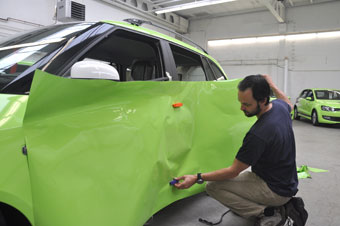For many sign shops, magnets have been relegated to a product that can only be marketed as an upsell beside pricier items like vehicle wraps. Some of these shops still consider magnets difficult to work with and produce, and they have trouble seeing the profit to be made from this particular product.
But these are all common misconceptions that have stuck around for too long. We spoke to a number of manufacturers to learn how shops can best profit from magnets.
Rethinking Magnets
Sign shops should first change the way that they think about magnets.
“As a sign shop, I don’t think they probably feel like they have enough of a range of products to work with to make that profitability,” says John DeLeon, director of Sales and Marketing for Flexmag Industries, a division of Arnold Magnetic Technologies. “As soon as they hear magnet, they think, ‘It’s going to cost me a lot, it’s going to be hard to get, and I don’t even know if I can run it on my equipment.’
“We’re trying to get the message across to sign shops that [magnets] are easy to work with. We’ve got products for almost any printer, however you want to print it, and there are certain magnets for certain applications that allow you to make a good profit from it.”
There are certain magnetic materials for certain applications because this is a reflection of how magnets should be sold—as a solution and as an applications-based product.
Magnets are not a production-driven product. It’s about the quality of the solution they offer rather than how many a shop can output.
And simply by offering magnets as a solution rather than just an add-on may help shops sell more of them.
“Here’s the thing: People aren’t going to come into the sign shop and say, ‘I want this in magnetic form.’ The sign shop has to turn that around and tell the people,” says DeLeon.
And what shops can do with magnets is offer clients a unique sign or display solution.
“Magnets can be a valuable component of a sign shop’s solutions for their clients’ projects because of their simplicity and functionality,” says Mike Gertz, marketing manager at Master Magnetics. “So rather than being an upsell or an add-on to projects, magnets might be the most efficient and cost-effective solution for their clients’ project challenge.”
Making Magnets
Producing magnets is a process that has become more efficient, as well. Shops can now print directly to the material using the printers they already have.
“For flexible magnets, printing direct-to-magnet saves time and money by eliminating the more labor-intensive two-step process of printing on a substrate and laminating to the magnet,” says Gertz.
In fact, most manufacturers recommend entirely throwing out the old process. “We do only recommend printing directly on magnet,” says Ryan Newhart, national account manager at Magnum Magnetics.
Despite these recommendations, some shops still carry misconceptions about the production process. Let’s dispel a few of these.
Magnetic Charge. Magnets will not harm wide format printers, as the magnetic charge is weak and stays on the surface. “The magnetic flux is barely an 1/8-inch off of the surface of the magnet so it’s not going to go anywhere,” says DeLeon.

Printing. Another common concern is that magnetic sheeting can’t be run through printers with metal parts, but there are fixes for this problem.
“A common obstacle is if the platen is made of metal, which would restrict the smooth and even flow of the magnet being fed into the printer,” says Gertz. “This is easily overcome by covering the platen with styrene, chipboard, vinyl, duct tape, or almost anything to create an air gap between the metal platen and the magnet, which then allows the magnetic sheeting to feed smoothly through their printer.”
Print quality on magnetic material shouldn’t be a concern for shops either.
“Whether it’s vinyl, paper, or other topcoats, today’s flexible magnetic sheeting topcoats allow for high-quality, high-resolution printing,” says Gertz. “There are a number of different manufacturers of magnetic sheeting, with different formulas for their printable surfaces. The best way to determine what to use is to test different sample rolls.”
(Note: See sidebar on page 30 for more printing-on-magnet tips.)
Choosing a Material. There are different magnetic materials for different applications. “Understand which magnetic products are best for the end application. I think there might be a little bit of a misconception now that there’s basically a magnet for one-size-fits-all type applications,” says DeLeon. “But if you really want to be profitable, there are magnet types that work for certain applications.”
For example, for indoor applications like refrigerator magnets, there is no need for vinyl or special coatings. Shops can save a bit of money and opt for a magnet with just a paper topcoat.
But for outdoor applications, shops will need a magnet with a topcoat that can withstand the elements. A shop’s supplier or magnet manufacturer will have more information on choosing the right media.
Products
So just what type of magnetic products and solutions can sign shops offer?
Magnetic-receptive Systems. These systems are one of the most popular options right now. Most magnet manufacturers offer them in some capacity, with the base being a magnet that attracts magnetic-receptive materials or a ferrous material that attracts magnets. Manufacturer Visual Magnetics even offers ActiveWall®, a Micro-iron® latex primer that “activates” an entire wall to accept both magnets and magnetic-receptive graphics.
There are many benefits to using a magnetic-receptive system: there is no need for a metal surface; installing and changing out graphics is easy; and systems that use magnets as a base allow for printing on magnetic-receptive sheets rather than magnets, which eliminates many printing problems.
“[Magnetic-receptive media] doesn’t stick to any of their printers,” says Joe Deetz, CEO of Visual Magnetics. “It prints just like standard papers so it really takes the mystery, the confusion, and the hard execution factor out of it.”
End-users are just starting to see the many benefits of the systems, as well. “They see the savings, and they see the way it brings quality of image, ease of installation, cost savings, and the ease of staying current with the campaigns very quickly,” says Deetz. “It will open doors that have been closed for people.”
Retail stores are using the systems for menus and promotional signage, but wall displays are becoming a big market, as well.
Magnetic Fasteners. There are fasteners that will affix a sign to metal surfaces, and two-piece magnetic fasteners that affix to opposite-pole magnets so that signs can be mounted anywhere.
“Magnets come in all sizes and strengths to handle most sign fastening situations,” says Gertz. “There are magnetic strips for fastening graphics, and there’s also an extensive selection of magnets and magnetic assemblies that are ideal for sign building.
“There are magnetic hooks, rings, and carabiners to hold up large, grommeted banners or hang signs from the ceiling; channel magnets to attach retail signs to store fixtures and gondolas; and super-strong neodymium magnets with foam adhesive to adhere signs or displays to metal.”

Flexible Magnetic Sheeting. This product can help shops break into a number of different markets with a number of different offerings. “There are so many industries and opportunities for sign shops to consider such as vehicle signs, magnetic business cards, menus, and calendars for all types of businesses,” says Gertz.
After the Sale
The relationship with the client doesn’t have to end when a shop hands over the product. In fact, many magnet manufacturers recommend sign shops at the very least put in a follow-up call.
“I think it’s important for our customers to follow-up with their customers on the end usage part to make sure everything goes smooth,” says Newhart.
Shops can also offer to print the next round of graphics for a client. This proves especially profitable with magnetic-receptive systems, which encourage the frequent change-out of graphic elements.
Still many sign shops may view being cut out of the installation as lost profits. But if the shop continues to produce graphics for a customer, it just means that the customers’ money has shifted from install to graphics.
“The power of being able to change parts of an image really brings value to the end-user and also you tend to have people print more often,” says Deetz. “What happens is that their budgets start to find 30 to 40 percent more money in them, so they end up utilizing more imagery in the store, boosting the brand, and keeping the store fresher. And they tend to change out more often.”
Education is the key to profiting with magnets. Shops should learn all they can about magnetic products and applications by speaking with magnet manufacturers and their printer manufacturers.











